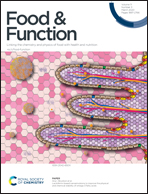The inhibitory activity of alginate against allergic reactions in an ovalbumin-induced mouse model†
Abstract
Marine seaweed polysaccharides have been considered as a potential resource for antiallergic therapy. Alginate is an acidic linear polysaccharide and soluble dietary fiber that was extracted from brown algae, Laminaria japonica. The molecular weight of alginate was 108 kDa, and its water solution exhibited non-Newtonian characteristics, including viscoelasticity and shear-thinning behavior. The ability of alginate to inhibit allergic reactions was investigated in ovalbumin (OVA)-induced BALB/c mice, which have been widely used as a mouse model of egg allergy. The results showed that alginate could effectively attenuate the occurrence of allergic reactions, including improving the integrity of the intestinal epithelial villi and inhibition of mast cell degranulation in the jejunum, in OVA-induced mice. Moreover, after treatment with alginate, the levels of IgE, histamine and IL-4 in OVA-induced mice were remarkably decreased, and the levels of IFN-γ were markedly increased. In addition, the number of Treg cells in spleen tissues in OVA-induced mice was increased by alginate, and the OVA-induced differentiation of Th0 cells into Th2 cells was significantly inhibited. These results demonstrate that alginate possesses potential antiallergic activities in a mouse model of egg allergy, which might provide important evidence that alginate, extracted from Laminaria japonica, can be developed into a novel functional food for inhibiting egg allergy.



 Please wait while we load your content...
Please wait while we load your content...